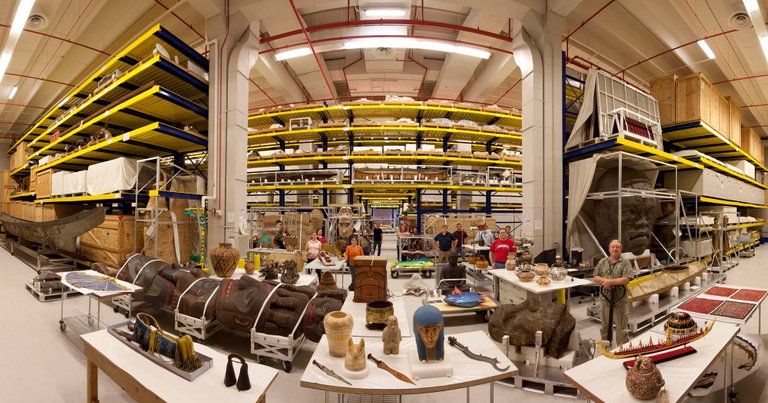We continue to discuss the problems in the Philadelphia cultural sector in class this week. Our readings dealt with two potential solutions, including a massive history center which would serve as the background and starting point for tourists, and a history system of some type, where history institutions could share resources.

The history center idea has many problems which several of my classmates have discussed. More interesting to me is the idea of a history system. This idea was discussed in one of our readings, Building a Sustainable Future for History Institutions: A Systemic Approach written by consultants at TDC. As the paper points out, cultural institutions like museums and archives often have much greater associated costs than other cultural institutions because they have to care for fragile historic objects, which are increasingly expensive to preserve. Because of this and my own interest in collections management, I’m going to focus on the collections side of things, and what I see as potential advantages and drawbacks.

How could history institutions collaborate as a system to share costs? The TDC points out that many institutions are unwilling to give parts of their collections, even if they make better sense at a different institution. However, what’s to stop them storing their collections together, in the same physical space?
What if a group of museums got together and built a shared storage facility?
There are many advantages. First of all, it would be cheaper to pool money to build and maintain one large state-of-the-art collections facility rather than build and maintain many smaller, less advanced facilities at each and every museum. Sharing the same location would also make life much easier for researchers, who could get access to multiple collections at once, and better compare, for example, different types of muskets from different museums at the same time. More efficient research use also benefits collections staff, who will lose less time to supervising researchers, ensuring security of studied objects, and retrieving objects, especially as these tasks could all be shared. It would also make loans between museums much easier, as staff could conduct all the required procedures in one place. It might make them more common, as the shared space may result in staff discovering and discussing objects that are relevant across museums. Sharing the space could also help in building community and collaboration between museums, as staff talk to each other and share best practices and innovative ideas. It would also provide an opportunity to catalog all the objects on the same software, making all of them searchable at once, and making collaborative digitalization projects much easier. Shared space and equipment would also make digitalization much cheaper for everyone, and perhaps make it possible for museums that otherwise couldn’t afford it. It would also free up existing collections space in museums, which could still be used for frequently needed objects, emergency storage, acquiring new objects, or be converted into admin or exhibit space. Best of all, no one has to give up their collections to other museums or deaccession anything.

Of course, there would also be some drawbacks, chief of which is storing collections off site. This would mean having to shuttle fragile objects to and from the main museum building any time an exhibit changes, which is neither easy nor cheap. Perhaps the museums could also share vehicles and transportation equipment stored at the shared collections space? Also, building the space initially would require a large investment of capital, as would moving everything there once complete. Also, many larger museums already have state-of-the-art facilities and very large collections, with adequate collections staff. They would have little reason to move. This solution would work better for smaller museums that need to maximize the use of every penny and/or currently have inadequate collections space.
I found a study done in Nantucket on creating a shared collections space. Perhaps a good starting point for a Philly shared collections space?
Another area I could see smaller museums sharing space and saving costs is administration. Why have part time or consulting accountants and payroll people instead of pooling resources and sharing one? Hopewell Furnace and Valley Forge share an administration even though they are 45 minutes apart, but still maintain separate collections and programs, and it seems to work pretty well. Of course it helps that they’re both part of the same government agency. I could go on more about this as well, but I think it’s time for your comments.

Do you think shared collections space would work? Would it help smaller museums? What other ways could museums team up to save money and provide better access, programming, and interpretation?
Sources: Elizabeth Cabral Curtis and Susan Nelson, Building a Sustainable Future for History Institutions: A Systemic Approach, TDC (Boston, MA: 2009).
Center for Public History and MLA Program, is exploring history and empowering education. Click here to learn more.100% of the SBD rewards from this #explore1918 post will support the Philadelphia History Initiative @phillyhistory. This crypto-experiment conducted by graduate courses at Temple University's
Excellent idea! And, as I remember it, I think it was in the late 1990s that the Conservation Center for Art and Historic Artifacts in Philly not only proposed but actually completed a business plan with partner institutions for just such a facility. The rise and (yes) fall of that plan is worthy of a deeper look to (one hopes) help explain the dynamics of this complicated and often conflicted field.
It's a shame that plan fell through. I have to wonder if it was primarily because of funding issues or a refusal to cooperate or some combination of both.